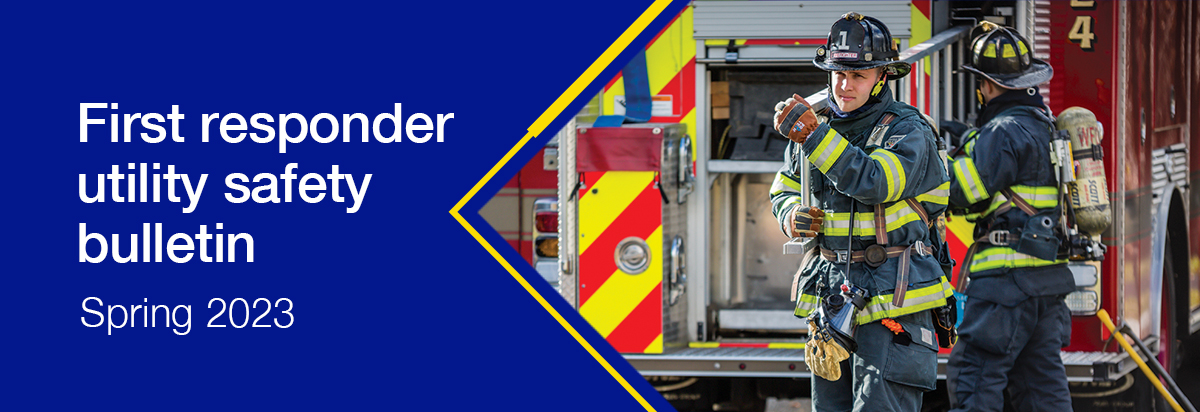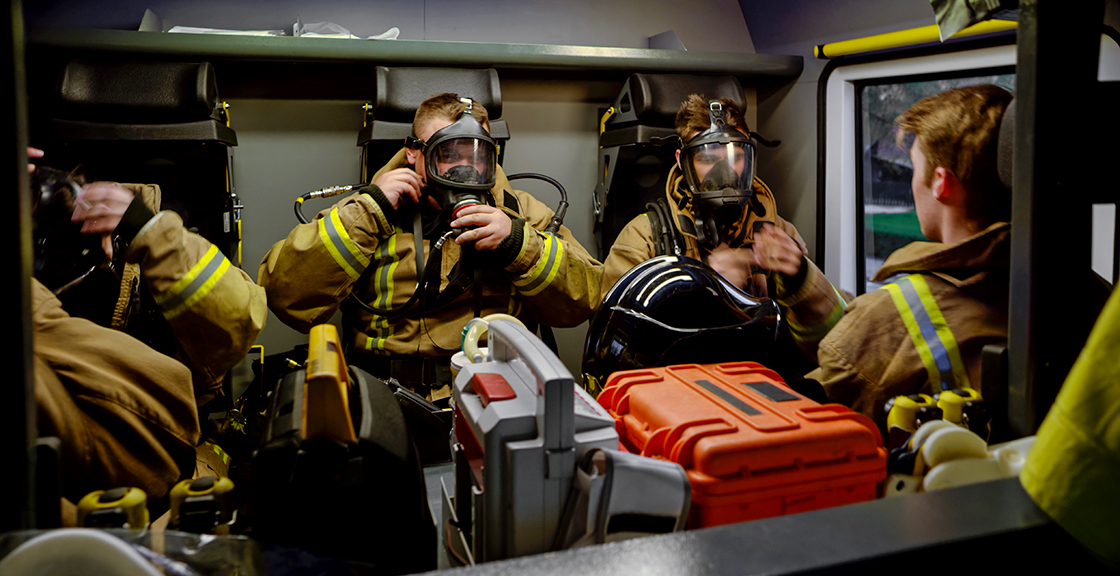| View in browser > |
 |
| Responding to gas odors from an unknown source |
|
Police and fire departments frequently receive reports of a natural gas odor from an unknown source. It can be frustrating to identify and mitigate the source of the odor, as reports often come from multiple points within an area and witness accounts often vary. Sometimes, reports come from the same area repeatedly and the odor dissipates without a source being identified. The consequences of a natural gas leak can be grave, so it is essential that you fully investigate any report of a gas odor as a potentially dangerous natural gas leak. |
|
|
Characteristics of natural gas
Natural gas is colorless and odorless, so Mercaptan, an odorant, is added to give natural gas its rotten-egg smell. Be aware that, although this odor often aids in detection of natural gas leaks, you may not be able to smell Mercaptan if you have been exposed to it for too long or if it is masked by other odors. Mercaptan may also be stripped from the gas due to chemical and physical processes. It may be filtered out by sand or gravel, or it may smell like something else when mixed with other substances in air. In addition, several substances may smell like Mercaptan, including sewer gas, decomposing proteins or chemicals improperly released into the atmosphere or sewer system. |
For all these reasons, never rely on your nose alone to determine whether a gas leak exists. You must use combustible gas indicators (CGI) to be certain whether dangerous levels of natural gas are present. |
 |
| Fire personnel should arrive at a gas leak incident in full PPE and SCBA. |
Response tactics
Upon receiving a report of a gas leak, your dispatcher should advise callers to evacuate the immediate area but remain on scene to provide the arriving fire officer with specific information. The dispatcher should initiate a public safety response to isolate and investigate the incident and then notify National Grid or the local natural gas utility and request an immediate response. In addition, the dispatcher should notify other municipal and public safety agencies, including the police department and possibly the Department of Public Works (DPW). |
Police and fire personnel should approach the incident scene cautiously. Stage vehicles upwind, away from the hazard area at a safe distance. If a leak is confirmed, a staging distance of 330 feet is recommended, if possible. Park safely out of the collapse zone of involved structures, and away from manhole covers, gas valve covers and storm sewer grates. |
Upon arrival, interview the reporting parties to obtain as much information as possible. Law enforcement personnel should evacuate the immediate area (100 feet) and reroute traffic away from your immediate operating area to minimize ignition sources and create an appropriate exclusion zone. If reports of gas odors recur in a specific area, never assume that the same situation exists because that’s what happened last time: Conduct interviews and evacuate each and every time. |
Personnel in full Personal Protective Equipment (PPE) and Self-Contained Breathing Apparatus (SCBA) should initiate air monitoring of the area and determine an appropriate exclusion zone that will ensure the safety of the public and provide a sufficient operating area for fire service personnel. |
 |
|
If air monitoring reveals a concentration of natural gas: |
|
| • |
|
Never enter a manhole, sewer or any other type of underground vault. |
| • |
|
Eliminate any potential sources of ignition, such as flame-producing devices and anything that could produce sparks. |
| • |
 |
Use intrinsically safe radios and flashlights. |
|
| • |
 | If you must approach the incident, do so with the minimum amount of personnel, each wearing full PPE and SCBA. |
|
| • |
 |
Monitor the atmosphere using multiple monitors if it is safe to do so. |
| • |
 |
Maintain a safe standoff distance from buildings with gas. |
|
|
|
|
Evacuate the area
When natural gas is present, establish an evacuation zone of at least 330 feet. First responders should notify occupants within the hazard area that they will need to relocate. Once the area is clear, use emergency vehicles, safety cones and/or barricades and barrier tape to mark the boundaries of the exclusion zone. |
Working with National Grid
National Grid personnel will respond to assist you, mitigate the leak, render the area safe and then restore service. Our personnel will report their presence to the incident commander (IC) and coordinate actions with you to resolve the situation. |
Based on policy, National Grid personnel are responsible for the following: |
| • |
 |
Inform the IC of the arrival of National Grid personnel and offer assistance. We recognize that an emergency incident is under the purview and control of the IC, and we will provide assistance. |
|
| • |
 |
Inquire whether the gas source has been controlled, provide guidance about the gas distribution system and mobilize resources to control the leak. |
|
| • |
 |
Offer to work with the IC as a non-governmental organization (NGO) in the incident command system. Typically, this is referred to as developing a unified command. |
|
| • |
 |
Secure gas service to the compromised gas infrastructure and work to eliminate ignition sources near the leak. |
|
| • |
 |
Upon request from the IC, work to detect combustible gas in structures that may have been affected by the event. |
|
| • |
|
Work with the fire department to ventilate structures, manholes, vaults and other sealed spaces or areas that have accumulated gas. |
| • |
|
Coordinate with other utilities whose infrastructure has been affected. |
| • |
|
Shut off all services fed by the compromised gas infrastructure. |
| • |
|
Provide public information to the media. |
| • |
|
Restart gas service once the compromised infrastructure has been repaired and the isolated area has been re-pressurized. |
|
|
|
Keep yourself, your team and the public safe this spring.
Visit firstresponder.ngridsafety.com today to register and
complete your utility safety training. |
|
|
|
| |
| |
|
| To report emergencies, call 911 and National Grid immediately. |
| |
 |
| In case of gas emergencies: |
 |
Long Island and the Rockaways:
911 and 1-800-490-0045 |
 |
Metro New York:
911 and 1-718-643-4050 |
 |
Upstate New York:
911 and 1-800-892-2345 |
 |
Massachusetts:
911 and 1-800-233-5325 |
 |
| |
|
|
|
|
| |
|
|
|
| |
| |
|
 |
#14229 © 2023 Culver Media, LLC |
|
| |
|
|
|
 |
|
|